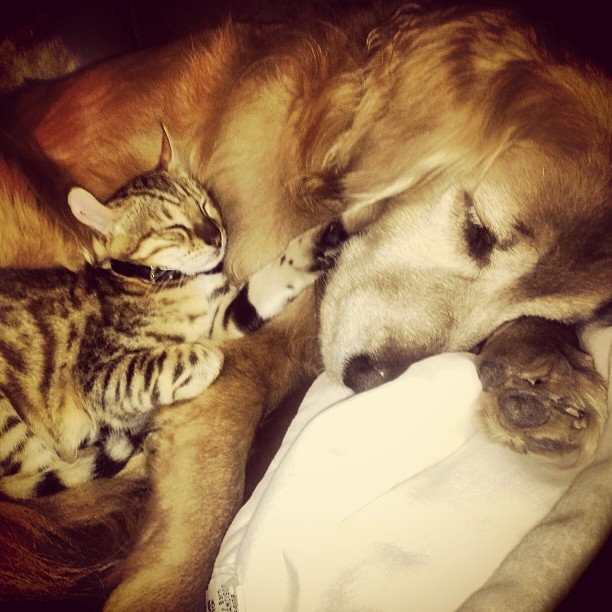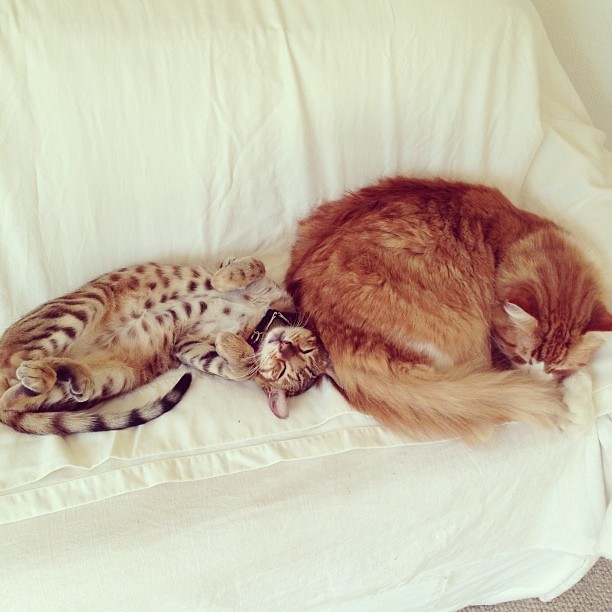There's nothing cuter than interspecies relationships and I personally melt into a puddle when I find my cats and dogs cuddling together. The absolute best is when I'm on the couch and I invite my dog, Daisy to jump up next to me and suddenly I'll find myself in the middle of a giant cuddle puddle of sweetness. Our kitten Tiger loves to cuddle up in Daisy's fluffy tail or right up against her belly in a little ball. Then Bear, our big orange fluffy cat will come over and lay right on top of me. Taj isn't into cuddling with cats and likes to pretend they don't exist, so he will come over and lay on my feet. I don't think there's anything else in my life that makes me feel so fuzzy and happy inside than when my animals choose to all come over and snuggle with me. One of my friends saw a photo of all of my animals together and said that it's the picture of harmony. I couldn't have described it better myself.

However, things weren't always so harmonious. Daisy has a pretty high prey drive for small , fast moving animals, aka kittens, so introducing a new family member had to be done very slowly and carefully. The more time and patience you put into introducing your dogs to a new cat or vice versa, the more successful the outcome. When we brought Tiger our new kitten home, we kept her in our bedroom for about a week. For the first few days, I let Daisy and Taj get to know her scent just by playing with Tiger and then letting the dogs smell me. I did not let the dogs see her or be in the same room with her for about three days. I wanted to "newness" of Tiger being in the house to wear off and I wanted Tiger to feel comfortable in her new home without feeling like some big monsters were going to barrel into the room and chase her under the bed. The first three days were crucial for our bonding time so that she could learn to trust me. I also made sure to give the dogs plenty of normal attention and play time.
After three days of playing it cool, I decided to bring the dogs into the bedroom on-leash one by one. With Daisy on leash, I used a clicker and lots of small-sized, smelly treats to reward her every time that she decided to look at me instead of the kitten. Then I asked her to stay in a down and continued to reward her for keeping her attention on me. It's important to keep everyone calm during this process and to keep the leash very relaxed. I also don't recommend holding the kitten or cat because they will feel trapped and even more fearful of the dog. After a day or two of several of these types of sessions, I dropped the leash and clicked/treated way less. I only clicked/treated when Tiger would make sudden movements or would get really close to Daisy to check her out. Around day five, I would let both dogs in the room with us at a time and then by day six everyone was well acquainted. By the end of the week, the dogs were intrigued, but completely welcoming and relaxed around the new kitten. Tiger was also feeling much more comfortable in her new surroundings (and successfully using the litter box!) so I decided to let her explore the rest of the house. While Tiger was dashing around and checking out every corner of her new playground, I did a few trick and treat sessions with Daisy and Taj to keep their attention on me and create a positive association with the new kitty in the house. Daisy and Taj were familiar with our cat Bear, making the process a lot easier, so if you're introducing your dog to a new cat here are some more pointers...
1) Work with your dog on basic obedience commands before you bring home your new cat. Especially work on sit-stays, down-stays, leave-it, staying calm with distractions and keeping attention on you.
2) Create a safe space for your new kitty. Introduce your cat and dog slowly. Don't overwhelm either of them and make sure they have spaces to get away from each other. You can also use an exercise pen if you don't feel like you have enough control of your dog on a loose leash. Sit with your dog inside of the pen while clicking/treating for good attention on you, while your cat hangs out in the room.
3) Judge your dog's reactivity. If your dog is intensely staring at your cat, stiffly wagging his tail, has a tense body and will not give you any attention while you call his name or make the kissy noise, your dog is still in a high prey drive mode and not ready to freely interact with your cat. If your dog can relax in the presence of the cat- low wagging tail, comfortably lying down, soft eyes, soft ears and able to give you attention at anytime- you may be able to move onto the next step of dropping the leash. Just go slow and do what you feel most comfortable with. If your dog has a severe prey drive, you may second guess bringing a cat into your home, or be willing to work really hard with attention clicker/treating exercises.
4) Use baby gates in your home to block off a room or two so that if your dog does try to chase your cat at some point, the kitty can jump the gates to safety. Also, make sure that your cat's food is up high and that your cat can't get to your dog's food or bother him while he's eating.
5) Give your dog lots of love, attention, exercise and play time even though you may be excited about hanging out with your new kitty. Dogs can get jealous and feel left out.
We've had Tiger as part of our family now for almost three months and we couldn't be happier with how well everyone is getting along. Even Bear, our older cat loves her and they chase each other around the house all day long. They stop for several cat naps and then they're at it again. To see Tiger cuddled up with Daisy just gets me every time. I've always considered myself a dog girl, but now I'm definitely a crazy cat lady too!




